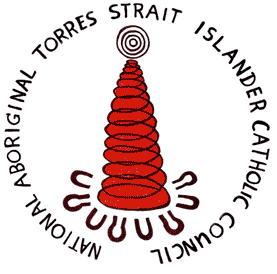
National Aboriginal and Torres Strait Islander Catholic Council

Aboriginal and Torres Strait Islander Culture has been in place for over 60,000 years in Australia and is the oldest surviving culture in the world. However, there was not a singular 'culture' shared by the thousands of language groups that covered the Australian continent at the time of settlement. Each group had different environments and differing kinship systems, dreamtime stories and spiritual beliefs. There were, however, constant threads throughout including the concept of a creator spirit that looks provides and watches over us. Aboriginal and Islanders are a spiritual people, a people who are aware of the spiritual reality of the land and of their own lives
When early Christian Ministries introduced the Bible to Aboriginal people, the Elders recognised many similarities between the Old Testament stories and traditional stories, laws and the teachings of God (or a creator Spirit). They believed and had faith in their Ancestor Spirit and relied on Him for all their needs. He was their Protector, Provider, Carer and Saviour. His name was honoured.
Traditional culture uses stories to teach about sharing, caring for eachother and the land and providing moral guidance. The stories throughout the bible serve the exact purpose - placed God's teachings into our own cultural context. An excellent example was provided by Pastor George Rosendale:
Then there is the story of the black and white cockatoos. They were brothers. One day the white cockatoo found the black cockatoo sitting under a shady tree looking angry and upset. ‘What is wrong, brother?’ ‘I’m angry with dad because he made me black. Why didn’t he make me like you? I’m going to change myself’. He went to his uncle’s country and asked him for honey and clay. ‘Get as much as you like, there’s plenty there’. He got the clay and honey and went back home. He powdered the clay and rubbed honey all over himself and put the powdered clay on. He looked at himself and said, ‘Now I look like my brother’. His granpa got so angry with him and he called on the monsoon to bring rain. It washed all the clay off him.
Later his brother came and spoke to him. He reminded him about his father’s love for him. He took him to the father and made things right again. Today the black cockatoo is happy. He’s singing when flying and feeding. Jesus our Big Brother has made things right for us. He has broken the barrier that kept us away from our Father and each other. (Eph. 2:11-22; Rom. 5:1-11.)
The story illustrates wonderfully the ways in which Aboriginal and Torres Strait Islander Catholics can adapt and see the similarities of the stories contained in the bible with traditional teaching and stories. The underlying lesson is clear, it is the context that provided the feeling of ownership of the teaching. Once these connections are made, the Gospel is perfectly relevant and at the centre of the faith systems of Aboriginal and Torres Strait Islander Catholics.
When I read the Gospels, I read them as an Aboriginal. There are many things in the Gospel that make me happy to be an Aboriginal because I think we have a good start .. Christ did not get worried about material things...
He was born in the countryside in a cave. like many of us have been born. He walked about like us and with nowhere to lay his head. He died with nothing on a cross. So many of our people die with nothing. He liked the bush as we do. He loved nature ... He loved the big things like the hills and open spaces. He loved the little things like the mustard seed and the grain of wheat and the com, drops of cold water and the little sparrows. We have similar 3 things like seeds and berries and yams, small water holes, and we like the quietness of the hills and the bush. Like him we have a deep sense of God in nature.
We like the way he uses the things of nature to teach, and the important part nature plays in the Sacraments ... We can appreciate also the community nature of the Church, because we are very conscious of being part of a group bound by Religious ties. We are strong on ceremony. through dance and song and painted bodies. Our ceremony closely involves groups and group participation... So the ceremony of the Mass, the ceremony of the Sacraments and the ceremony of the liturgy should find a ready response in us, provided it is made meaningful, based on a theology that is tuned to the Aboriginal mind.
Deacon Boniface Perdjert
National Aboriginal and Torres Strait Islander Catholic Council
'The peak Indigenous advisory body to the Catholic Church'
80C Payneham Rd.
Stepney SA 5069
www.natsicc.org.au | craig@natsicc.org.au | 08 8363 2963
